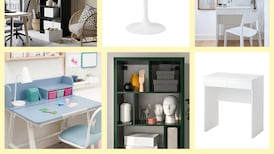Modern Country is a publication that has vetoed traditional thinking on what the country look for homes should be. There isn't a single oilcloth-covered kitchen table on any of its glossy pages, no overstuffed sofas filling up living rooms, there's hardly a dresser in sight and the orange-brown kitchen cupboards that showrooms like to describe as country pine are utterly absent. That floral patterned, busy interior has been set in decorative aspic.
The book’s author, Caroline Clifton-Mogg, says the new thinking reflects a relaxed, more informal way of life. “The essence of living in the country is to live more simply. What modern country means is that people live in a less formal, less fussy way. We like things to be pared back. These houses and rooms epitomise that and through glazing welcome in nature, in all her best guises; mountain highs, great green pastures and living by the seaside.”
The homes and rooms she's talking about were originally photographed for French interiors magazine Côte Maison, and while there is a Francophile feel to some pages, the coffee table tome has many ideas that translate well to our own more temperate climate.
0 of 3
Lots of the properties are second homes and have been converted from their original use. A shepherd’s cottage is now a mountain retreat. A barn, historically used to store things, is now a family hub in the middle of green fields. The looks are acres away from hillbilly because the way we use space has changed, Clifton-Mogg says. “Living space is much more general now, it’s less about small rooms used only for formal occasions. Now if refurbishing an old country house with a traditional scullery kitchen and separate dining room, most people will automatically knock these rooms through to create a larger more inclusive space.”
Most of these homes have been opened up to bring as much of the outside in. Where possible, there is glazing to look out at the pastoral surroundings, which are as much part of the architecture as the formal structure itself. Barn doors have been replaced by metal framed glass alternatives, sometimes with the original barn doors used as exterior shuttering to protect the glass from the elements and close up the house when it is vacant.
Corrugated iron sheeting, a vernacular material that has been used in Irish farm life for generations – you still see it rusting red atop stables, byres and hay sheds – has been given a radical rethink. It is used as a wall and ceiling material, creating a wavy place to bed down and on some of the pages it has been painted an eye-popping turquoise blue.
In a house in the country, you want to make use of the building’s natural elements. Rustic original features such as ancient timber beams are retained to add atmosphere and a sense of authenticity. But they now share the space with brand new wooden floorboards or smooth plastered walls.
Clifton-Mogg is all for pushing the envelope on fresh ideas. Ancient wooden beams don’t have to remain pitch black or stained dark brown – they were only ever treated so to preserve the wood, she says. She’s considering painting the rafters in her holiday home in France a hot pink and washing the walls in a complementary, soft marshmallow pink that also happens to be very now. “By painting the wood a colour you are creating a composition,” she explains. “Alternative thinking is always a good idea.”
Scrubbed pine, a country house staple, is paired with a polished concrete floor or an exposed stone or brick wall to add new and contrasting textures, rather than being teamed with traditional kitchen chairs in a matching finish. One homeowner used blocks of wood as dining stools – a smart way of bringing in the surrounding forest.
In a country setting, the area outside the home is as important as that inside. In one feature, a tree that predates its new residents is kept in situ while the surrounding area becomes a terrace. In another, an ochre house outside Marrakech, traditional tadelakt, a native waterproof lime plaster, is used to build walls, curves and floors.
Making the outdoor space comfortable is essential, she says. “Invest in comfortable, almost armchair-like seating, sheepskin rugs and blankets to keep the autumnal chills at bay and an outdoor fire. Then just sit outside and look up at the stars – a far more exciting screen to watch than the television.”
The simple look is difficult to get right in a rustic environment, she cautions. "Less is always more. Too much stuff makes a space look fussy. Don't be tempted to buy fitted carpets. It should look and feel simple. You want to be able to unburden yourself, unclutter your mind, open a good bottle of wine and relax. It's about not having the everyday stuff around you cluttering your home and mind." Modern Country by Caroline Clifton-Mogg is published by Quarto, £30













